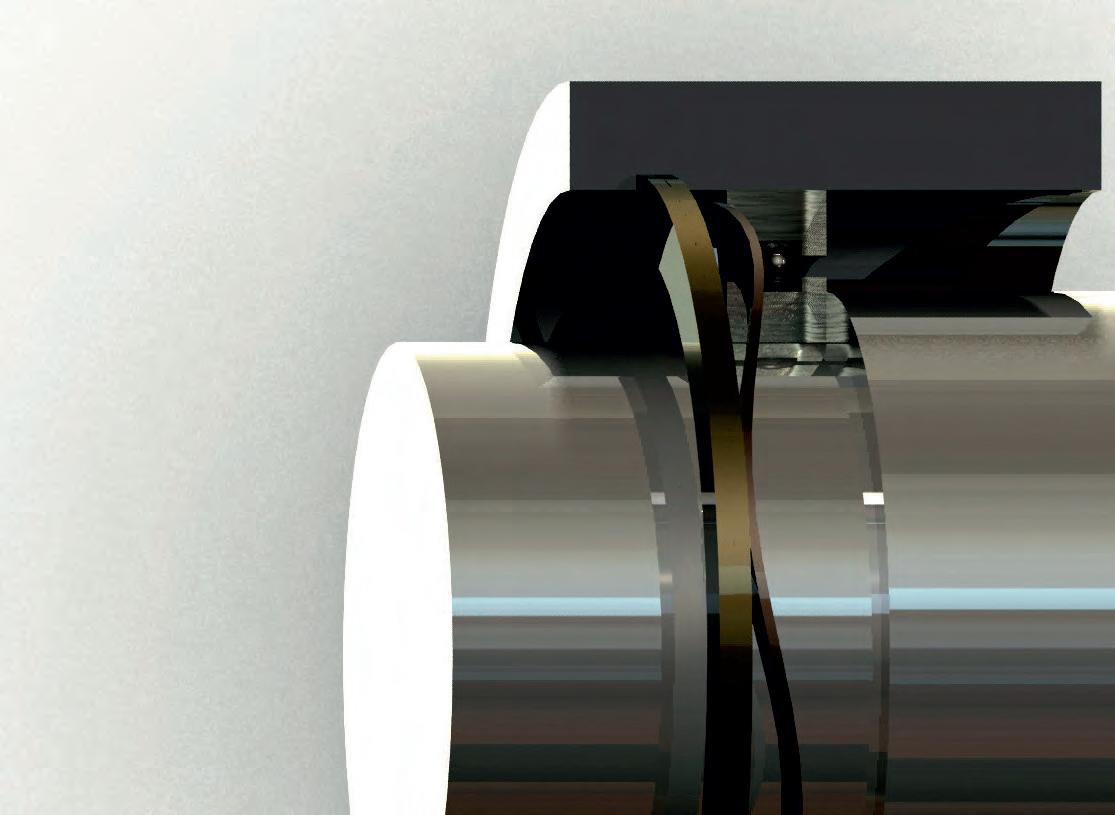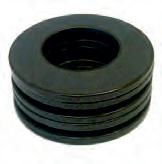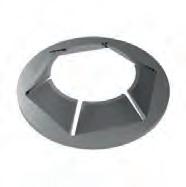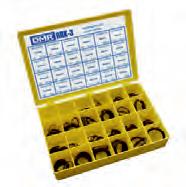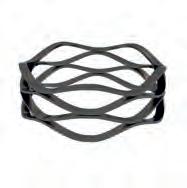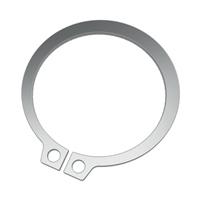CAD REPORT
CAD giant PTC heads to the Cloud with Creo+ p.10
FLUID POWER
How smart pneumatic sensors reduce energy use and carbon emissions p.20


IIOT
How MQTT works and why you might want to use it p.14

CAD giant PTC heads to the Cloud with Creo+ p.10
How smart pneumatic sensors reduce energy use and carbon emissions p.20


How MQTT works and why you might want to use it p.14
Toronto’s Xaba.ai looks to disrupt the use of manufacturing robotics with an industrial AI.

Designing efficient systems involves much more than simply understanding a few basic principles. There is a true art to balancing the specific requirements of an application in order to achieve the desired goals in the best possible way. Help us understand the unique needs of your application and together, we’ll develop something that surpasses what any of us could have done alone.
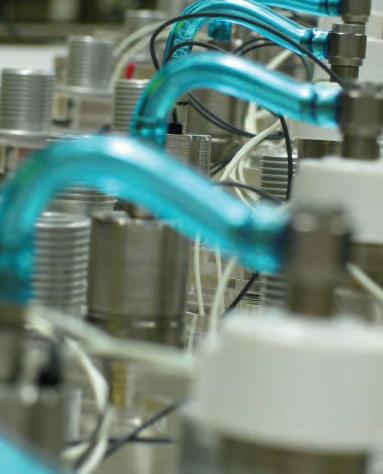



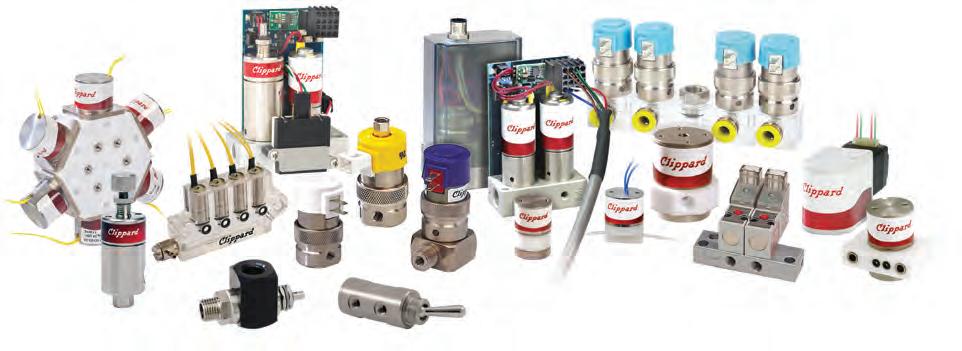
Contact



obot Brain
Toronto’s Xaba.ai looks to disrupt the use of manufacturing robotics with an industrial AI

HMS Networks report details Ethernet protocol market share in 2023
How Smart Sensors Optimize essed Air Use


Applying smart pneumatic sensors to compressed air applications can reduce energy use and lower


6 Design News
Distributed AI technique accelerates picking robot training and other engineering news
10 CAD Report
CAD giant’s Creo+ integrates online collaboration and administrative functions
22 Idea Generator
The latest in industrial products including fluid power, motion control and robotics
When someone brings up the topic of IIoT or digital transformation, the often quoted statistic – 70% of initiatives fail to deliver – inevitably comes up. Factors playing into that discouraging figure include initiatives that were overly ambitious, implemented the wrong technology (e.g. doesn’t scale, tries to be all-encompassing, requires too much time/money) or simply lacked clearly defined goals from the get go
Those are common deal killers, but one that doesn’t gets enough attention is more of a people problem than a technical one: People typically don’t like to change the way things operate. My impression is there’s really only one group in an enterprise that relishes a new approach like IIoT and that’s engineers.
By nature, they love data, strive for increased efficiency and relish nothing more than an intellectual challenge. Leave a thorny puzzle like digital transformation or a scrambled Rubic’s Cube laying around, and see what happens. Like a rottweiler with a rawhide bone, they’ll clench it their jaws, slink off to a corner and chew on it until they get sick.
They also bridge the no man’s land between the carpeted boardrooms of IT and upper management and the concrete halls of production and maintenance. The problem is, being in the middle, the onus then fall on them to cajole the other layers of the organization, whose response may range from skeptical to openly hostile. Say “digital transformation” and management hears “profit loss”, IT hears “cyber threat” and the shop floor hears, “another damn thing we’ve got to do that isn’t making product.”
In his recently published book, Myth to Reality: Harnessing the Power of Industry 4.0 for Manufacturing Success, Jason Bean lays out what he’s seen as pivotal to success over his 30 years in automation. To address this problem, the Cambridge, ON-based author – who serves as Pepperl+Fuchs Canada’s IIoT Market Specialists – recommends building an IIoT team composed of receptive players from all depar tments. He also emphasizes the importance of story telling. That is, framing the task in a way inspires others to see how digital transformation will streamline their sphere and provide the information and tools to fix their own problems.
At the end of the day, digital transformation boils down to collecting, mingling and analyzing formally silo-ed OT, IT, scheduling and financial data to enable capabilities ranging from predictive maintenance to digital supply chain. For that to happen, however, “de-siloing” the people who gatekeep that data is a crucial initial step in any digital transformation.
MIKE MCLEOD
Editor
mmcleod@design-engineering.com
Editorial Board
DR. ALAIN AUBERTIN
President & CEO, Canada Consortium for Aerospace Research and Innovation in Canada (CARIC)
DR. MARY WELLS, P.ENG
Dean, Faculty of Engineering / Professor, Mechanical and Mechatronics Engineering; University of Waterloo

AJAY BAJAJ, P.ENG
President and CEO, Rotator Products Limited; Past President and Board Member, Power Transmission Distributors Association (PTDA)
DR. ISHWAR PURI, P.ENG Vice President of Research; Engineering Professor, University of Southern California
SEPTEMBER 2023
Volume 68, No.4 design-engineering.com
READER SERVICE
Print and digital subsciption inquiries or changes, please contact
Angelita Potal
Tel: (416) 510-5113
Fax: (416) 510-6875
Email: apotal@annexbusinessmedia.com
Mail: 111 Gordon Baker Rd., Suite 400, Toronto ON M2H 3R1
SENIOR PUBLISHER Paul Burton (416) 510-6756 • pburton@annexbusinessmedia.com
ASSOCIATE PUBLISHER Kathryn Swan (416) 510-6757 • kswan@annexbusinessmedia.com
EDITOR Michael McLeod (416) 442-5600 ext. 3231 mmcleod@design-engineering.com
NATIONAL ACCOUNT MANAGER Ilana Fawcett (416) 829-1221 • ifawcett@annexbusinessmedia.com
ACCOUNT COORDINATOR Cheryl Fisher (416) 510-5194 • cfisher@annexbusinessmedia.com
AUDIENCE DEVELOPMENT MANAGER
Beata Olechnowicz (416) 510-5182 • bolechnowicz@annexbusinessmedia.com
PRESIDENT/COO Scott Jamieson sjamieson@annexbusinessmedia.com
Design Engineering, established in 1955, is published by Annex Business Media, 6 times per year except for occasional combined, expanded or premium issues, which count as two subscription issues.
Printed in Canada
Publications Mail Agreement #40065710
ISSN: 0011-9342 (Print), 1929-6452 (Online)
Subscriber Services: Canada: $57.50 for 1 year; $92.50 for 2 years; $10 for single copy.
Outside Canada: USA - $140.50; Overseas - $151.00; $10.00 for single copy.
All prices in CAD funds. Add applicable taxes to Canadian rates.
From time to time we make our subscription list available to select companies and organizations whose product or service may interest you. If you prefer not to receive this information, please contact our circulation department in any of the four ways listed above.
Annex Business Media Privacy Officer: privacy@annexbusinessmedia.com
Tel: 800-668-2374
No part of the editorial content of this publication may be reprinted without the publisher’s written permission.
©2023 Annex Business Media. All rights reserved. DE receives unsolicited features and materials (including letters to the editor) from time to time. DE, its affiliates and assignees may use, reproduce, publish, re-publish, distribute, store and archive such submissions in whole or in part in any form or medium whatsoever, without compensation of any sort. DE accepts no responsibility or liability for claims made for any product or service reported or advertised in this issue. DE is indexed in the Canadian Business Index by Micromedia Ltd., Toronto, and is available on-line in the Canadian Business & Current Affairs Database.
Levitating planar movers
6D motion Scalable payload kg
Velocities up to 2 m/s
XPlanar enables new dimensions of freedom in product and material handling: Levitating planar movers fly over flexibly arranged planar tiles accommodating nearly any track layout and path planning.

Individual 2D transport at up to 2 m/s
Processing with up to 6 degrees of freedom
Transport and processing in one system
Wear-free, hygienic and easy to clean
Free arrangement of planar tiles enabling totally customized machine and process layouts
Multi-mover control enables parallel and individual product handling
Fully integrated into the powerful and standardized PC-based Beckhoff control system (TwinCAT, PLC IEC 61131, Motion, Measurement, Machine Learning, Vision, Communication, HMI)
For use across all industries: assembly, packaging, food/bev, pharma, laboratory, entertainment, …

Festo announced the successful conclusion of a research project aimed at making picking robots more intelligent using a distributed AI technique. Called FLAIROP (Federated Learning for Robot Picking), the project is a collaboration of researchers at Festo and the Karlsruhe Institute of Technology (KIT), as well as, Waterloo-based start-up Darwin AI and researchers at the University of Waterloo.
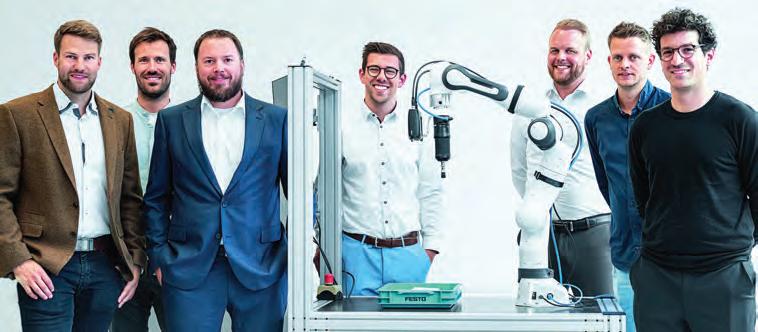
The crux of the research looked at federated learning, a distributed machine learning technique that allows AI-enabled robots to learn from each other but without sharing proprietary training data.
Typically, the process of federated learning begins with a generic baseline machine lear ning model, a copy of which is distributed among various local robots (e.g. three pick-and-place robots at three different companies). As each robot uses the baseline model to learn a specific task, their generic models become unique.
Those changes are then contributed back to a central server where they are averaged together to create a new modified baseline model. That refined model is then redistributed to each robot, and so on, becoming increasingly diverse in its knowledge with each iteration. Since the baseline model is always an amalgamation of all the changes, it doesn’t retain or depend on any one contributor’s training data.
For the FLAIROP project, the research team set up five autonomous picking stations: two robots at the KIT Institute for Materials Handling and Logistics Systems (IFL) in Karlsruhe, Germany and three at Festo’s operations in Esslingen, Germany.
Each cell was equipped with cameras to visually detect the items in front of them. Based on the camera image, each robot arm learned to recognize different
items and select a suitable gripping method. With each iteration of the distributed model, each robot improved its grasping point detection, even for items it hadn’t previously be trained to recognize.
“We have developed a universal, simulation-based data set that we can use to train autonomous gripping robots in such a way that they are able to reliably grasp items that they have not seen before,” said Maximilian Gilles, research assistant at the KIT Institute for Materials Handling and Logistics Systems.
The implications of the project, the researchers say, could be far reaching. Take an automated bin picking cell in a manufacturing warehouse for example. Instead of isolated systems at different companies having to each learn how best to grasp hundreds or thousands of items individually, each of those systems could learn a fraction of the total items and share their generalized grasping dexterity with all the others.
www.festo.ca
www.ifl.kit.edu
$18.9B IN 2023, ANALYST REPORT SAYS
A recent report by market research firm, Interact Analysis, forecasts that the motion controls
market will return to steady growth following a period of high demand for consumer products in 2021/2022 which boosted investment in automation. In total, the fir m anticipates the global motion controls market will be worth $18.9B in 2023, a rise from $17.7B last year.
In 2022, the report says China lead the APAC region, which accounted for 37% of global motion controls revenues, followed by Europe, the Middle East, and Africa (EMEA) at 33% and Japan and the Americas (16% and 14% respectively).
This year, the report projects that while the Asia-Pacific region (APAC) will remain the largest market, the Americas will show the highest growth rate: 7.4% in 2023. Even so, the firm expects global growth of the sector to fall in 2024 but bounce back in the mid- to long-term. Interact Analysis’ research found that
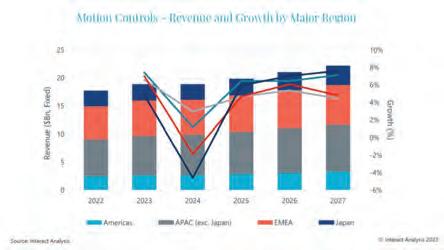
while some vendors were optimistic about the pace of growth, anticipating rates as high as 20%, others were more cautious, anticipating a flat year compared to 2022.
Globally, the Americas is expected to suffer last from the impending market slowdown, with some of the largest industries for motion controls, such as semiconductors and electronics machinery, performing well due to the uplift from the U.S. CHIPS and Science Act.
The analysts firm foresees a decline in demand for industrial automation in 2024, due in part to interest rates and high inflation. Even so, the firm forecasts the global motion controls market will grow with a CAGR of 4.6% between 2022 and 2027, increasing from $17.7bn to $22.2bn. https://interactanalysis.com


Purdue University researchers announced the development of a 3D machine vision sensor that can perceive texture and depth data in low or no light environments. Called HADAR (heat-assisted detection and ranging), the technology combines thermal physics, infrared imaging and machine learning in a way that paves the way to fully passive and physics-aware machine perception, the researchers say.
Family School of Electrical and Computer Engineering.
Traditional thermal imaging is a fully passive sensing method that collects invisible heat radiation originating from all objects in a scene. Like HADAR, it can sense through darkness, inclement weather and solar glare, but is hindered by fundamental challenges, the researchers said. For example, objects and environments emit and scatter thermal
radiation which results in a loss of information.
Similarly, LiDAR (light detection and ranging) radar and sonar emit and receive signals to collect 3D information but suffer from signal interference as they are scaled up. Video cameras depend on sunlight or other sources of illumination and therefore don’t work well in low-light conditions, fog and rain.

“HADAR vividly recovers the texture
“Our work builds the information theoretic foundations of thermal perception to show that pitch darkness carries the same amount of information as broad daylight,” said Zubin Jacob, the Elmore Associate Professor of Electrical and Computer Engineering in the Elmore
from the cluttered heat signal and accurately disentangles temperature, emissivity and texture, or TeX, of all objects in a scene,” said research scientist Fanglin Bao, who co-developed HADAR with Jacobs. “It sees texture and depth through the darkness as if it were day and also perceives physical attributes beyond RGB, or red, green and blue, visible imaging or conventional thermal sensing.”
Initially, the researchers foresee their HADAR TeX vision applied in automated vehicles and robots that interact with humans in complex environments. The technology could be further developed for agriculture, defense, geosciences, health care and wildlife monitoring applications. However, they say the size of the hardware and the data collection speed will need to be improved first.
“The current sensor is large and heavy since HADAR algorithms require many colors of invisible infrared radiation,” Bao said. “To apply it to self-driving cars or robots, we need to bring down the size and price while also making the cameras faster. The current sensor takes around one second to create one image, but for autonomous cars we need around 30 to 60 her tz frame rate, or frames per second.”
https://engineering.purdue.edu
Ribbit, a Toronto-based cargo airline startup developing software for autonomous flight, announced it has signed a CAD$1.3M contract with Transport Canada and Innovative Solutions Canada to begin testing self-flying aircraft in northern Canada.
The company says it has completed more than 200 hours of hands-free flight on a two-seat airplane, and is rapidly advancing operational testing in preparation for commercial service.
As part of its contract with Transport Canada, Ribbit will
provide a single aircraft, along with remote crew and maintenance services, to sustain autonomous cargo flights for one year. For its part, Transport Canada will use the flight data to inform future aviation regulations, standards and policy.
“Many rural and remote areas are served by larger airplanes that fly infrequently,” said CEO Carl Pigeon. “Ribbit takes a smaller aircraft and uses autonomy to drastically change the unit economics of that plane. This lets us offer reliable next-day or two-day service and improve supply chains.”
Ribbit says it was issued a Special Flight Operations Certificate in 2022 author izing uncrewed flight tests. To date, the company says it has received letters of intent from retailer s totaling $42 million per year.
www.flyribbit.com
A long standing goal in the robotics fields has been to recreate the dexterity of the human hand. While force and torque sensors provide feedback for robotic systems currently, traditional sensors are hindered by limited customization and can’t typically be attached to arbitrary objects.

Researchers from the Munich Institute of Robotics and Machine Intelligence (MIRMI) at the Technical University of Munich
(TUM), however, announced the development of an automated process to create flexible universal measurement cells.
According to the researchers, their soft, skin-like material can be wrapped around almost any kind of object, expanding the potential of robotics and prosthetic devices. It’s the way the skin is made, the researchers say, that allows it to freely conform to whatever surface it covers while also providing precise, real time data.
“We use software to build the structure for the sensory systems,” said Diego Hidalgo, who developed the process with fellow MIRMI researcher, Sonja Groß. “We then send this information to a 3D printer where our soft sensors are made.”
To create the skin, a 3D printer injects conductive ink into liquid silicone. As the silicone hardens, the ink remains liquid, acting as a sensor and flexible conductive traces within the material. When the sensors are squeezed or stretched, their electrical resistance changes.
“That tells us how much compression or stretching force is applied to a surface,” explained Hidalgo. “We use this principle to gain a general understanding of interactions with objects and, specifically, to learn how to control an artificial hand interacting with these objects.”
The MIRMI team presented their research at the 2023 ICRA robotics conference in London. www.mirmi.tum.de






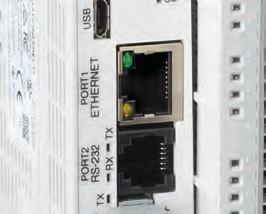






















For





CLICK PLUS PLCs provide the same simple, practical control the CLICK PLC line is known for but with some surprising bells and whistles. Data logging, Wi-Fi connect-ability, MQTT communication, and increased security measures are just a few of the impressive features offered with the CLICK PLUS PLC series. Using the same FREE streamlined PLC programming software as its predecessor, CLICK PLUS PLCs provide straightforward, no-learning-curve programming. Combine that with a starting at price of just $97.00 and the CLICK PLUS PLC is undoubtedly the unmatched value leader!
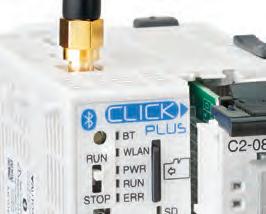


Our shipping policies make it easier














Fast free standard shipping* is available for most orders over $49 U.S., and that includes the brokerage fees (when using an AutomationDirect nominated broker). Using our choice of carrier, we can reach most Canadian destinations within 2 to 3 days.
*Free shipping does not apply to items requiring LTL transport, but those shipments can take advantage of our negotiated super-low at rates (based on weight) that include brokerage fees.


See Web site for details and restrictions at: www.automationdirect.com/canada




















It is no longer enough for software vendors to sell only one kind of software. CAD programs have matured to the point where they accomplish pretty much anything we need to do. So, CAD vendors have reached for other ways to increase revenues, such as by forcing annual payments and by expanding the kinds of software they sell.
Dassault Systems, for instance, invented PLM (product lifecycle management) as software that expands indefinitely to cover the birth, life and afterlife of all kinds of products, even clothing and pharmaceuticals.
PTC is one of the oldest CAD vendors, and it too added PLM through their Windchill product. Then it kept on expanding, into areas like IoT (Internet of things), AR (augmented reality), ALM (application lifecycle management), and other acronyms that we in CAD may rarely hear of.
Going way beyond the realm of CAD, PTC this year acquired ServiceMax, its most expensive acquisition ever. CEO Jim Heppelmann figures he can make ten times more revenue from SLM (service lifecycle management) that handles the servicing of products than from PTC’s CAD software that designs the products.
Ser viceMax works with cloudbased asset records and connects through PTC’s ThingWorx to other functions, such as warranty claims (PTC Warranty), 3D work instructions (Vuforia), spare parts management (Servigistics) and service information (Arbortext).
Another source of on-going
BY RALPH GRABOWSKIrevenue is cloud-based software; however, Windows-coupled programs can’t be easily ported to the cloud. The underlaying foundation of data read-write, multi-user access and browser-based interactions are so fundamentally different between the desktop and the cloud that software must be rewritten from scratch. Only a few CAD vendors took on this task, such as Autodesk (Inventor to Fusion), Dassault Systemes (Solidworks to Xdesign), and Graebert (Ares to Kudo). Many found that their cloud versions sold poorly relative to the desktop ones. Siemens never bothered.
In the case of PTC, it began rewriting its Creo MCAD software for the cloud, then decided it might take too long and cost too much to catch up with competitors. As a shortcut, it bought Onshape for half-a-billion dollars, even though it runs on a different kernel (Parasolid) and uses a non-file database str ucture, meaning Onshape always has to translate designs from Creo.
Following the acquisition, PTC wrote a new foundation program for its cloud-based programs, called Atlas, to employ Onshape’s multi-user data-access

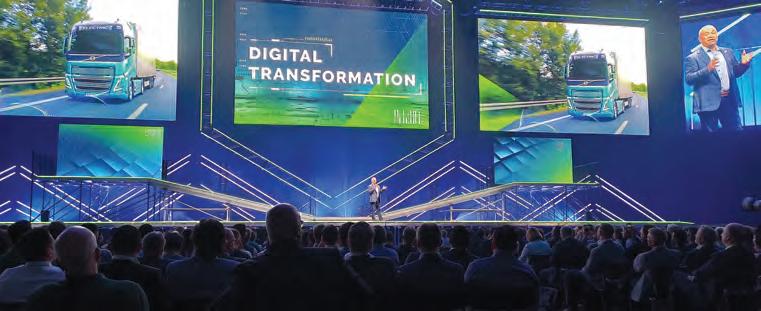
and licensing capabilities.
It’s been four years since then, and Creo finally received a couple of Web-friendly extensions. They handle collaboration a nd administrative tasks under the name of Creo+. This is not particularly advanced, and other MCAD programs added them several years ago, even smaller ones like BricsCAD.
Collaboration means two or more licensed Creo+ users can work on the same model at the same time. Particularly useful here is the integration into Creo+ of Onshape’s revise-andmerge control (renamed “collaboration graph”), where users make changes to the model independently of one another, and then upon approval merge the
Introducing CoroDrill® 860 with -GM geometry, the new short-hole drill optimized for a wide range of applications in steel, stainless steel, cast iron and hardened materials.
CoroDrill® 860 with -GM geometry sets the standard for optimized multi-material drills, providing several benefits for your production.
• Significantly increases tool life in ISO P, M, K and H materials. Also effective in ISO N and S materials
• Robust new design provides excellent hole dimensional accuracy with improved tolerance and surface finish
• One drill for all materials offers great machining flexibility, leading to reduced set-up time and stock holding
www.sandvik.coromant.com/corodrill860
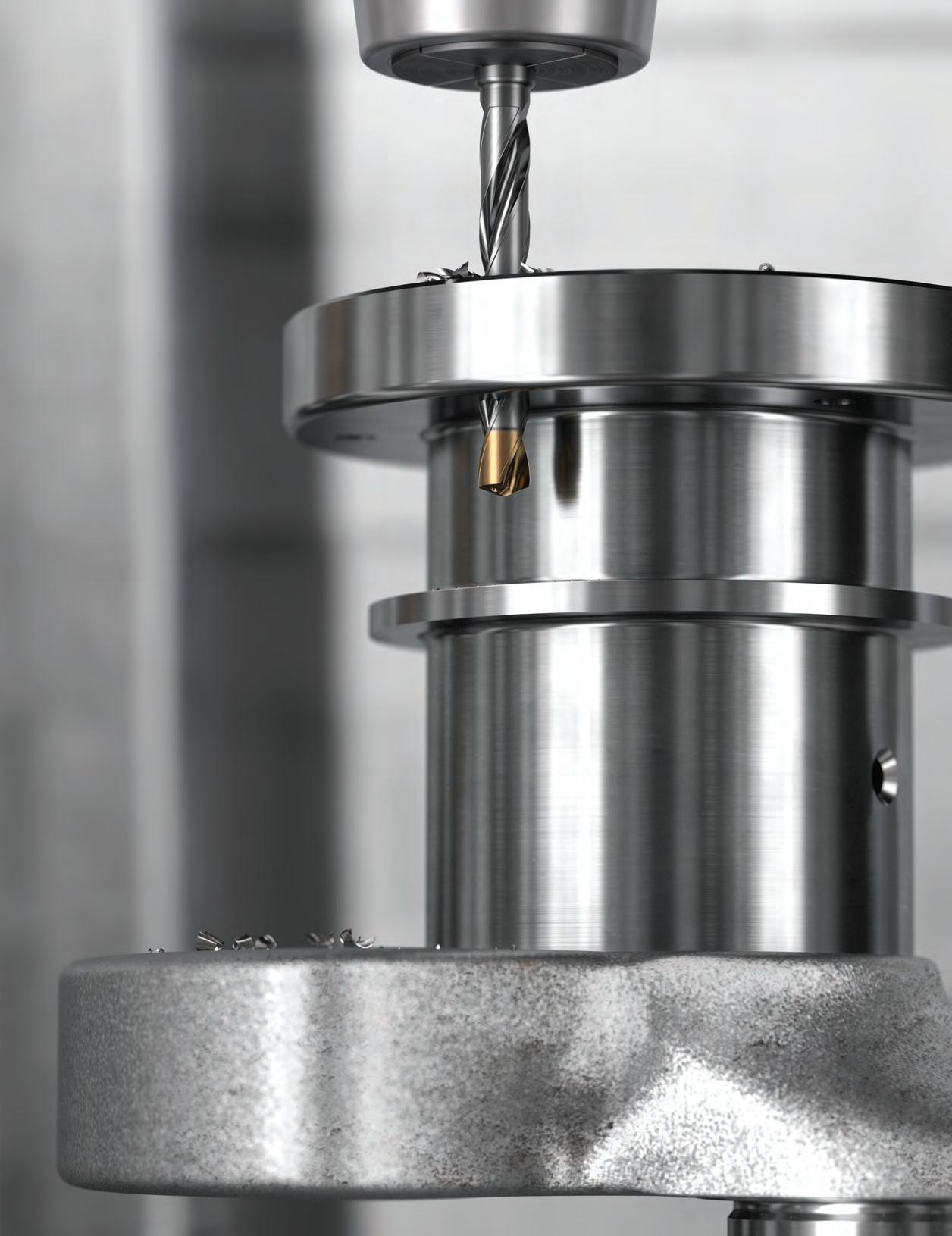
changes. Missing is a free Creo+ viewer that would let non-users attend the meetings.
Administration means licenses are controlled remotely. Users can be assigned versions of, and extensions to, Creo+ according to their job duties and for durations as short as 24 hours. For instance, through time sharing, one license of the tool design extension can be used by more than one employee. Other extensions to Creo+ include advanced assembly, interactive surface design and ANSYS simulation. For managers, telemetry collects information on how Creo+ is being used.
PTC plans to update Creo+ every three months, a slower pace than Onshape’s rather brisk three-week update schedule. (PTC calls this quick development “agile.”) Reverse compatibility will not be available for Creo+ and so updates will be forced on users of Creo+ to maintain compatibility. PTC acknowledges that forced upgrades might not be popular, so it will provide previews of the next upgrade up to four weeks in advance.
Currently, Creo+ is desktop-bound, and it won’t be until sometime in 2024 (PTC hopes) that you’ll be able to stream it through supported Web browsers. PTC calls cloudbased software “SaaS,” short for software-as-a-service, and calls the desktop software “on-premise.” Creo itself was the result of merg ing the Co/Create direct modeler, originally ME/30 acquired from HP, with PTC’s own Pro/Engineer parametric modeler; both from the 1980s.
PTC CEO Heppelmann acknowledged at the company’s annual Liv eWorx conference in May that going on the cloud has security hazards. He revealed that his greatest fear is not some new technology from a competitor, but debilitating malware that shuts down the
PTC’s Creo 10 now performs Boolean operations on multi-body models, such as split and trim, and adds more ways to warp and style surfaces.
entire cloud-based portion of his company in minutes, with the damage lasting months – as has occurred to some other corporations.
What’s New
Creo 10
The new release of Creo 10 now performs Boolean operations on multi-body models, such as split and trim, and adds more ways to warp and style surfaces. In electrical design, such as for cars, harnesses can be split and merged.
There are new functions that
certain disciplines will use a lot, such draping cloth and parametric visual fields. The latter one allows for the positioning of manikins and their fields of view, such as in a factory or through car windows. Being parametric, the view changes as the model is updated or the manikin is repositioned.
PTC gets its simulation software from ANSYS. New features for advanced thermal and structural analyses include nonlinear contacts and mater ials.

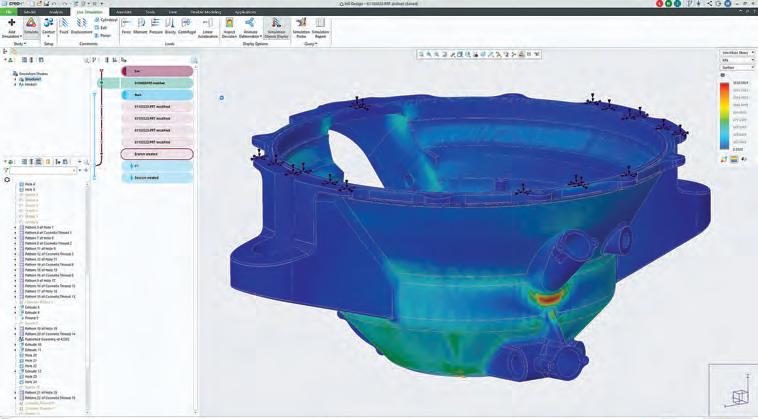
Several years ago, PTC bought generative design software firm Frustum and has been adding its capabilities to Creo. This year, generative design can model auxetic cells – that is, materials that get thicker when stretched.
Unlike Dassault, PTC isn’t pressuring Creo users to adopt Onshape. The company acknowledges that the on-premise Creo user has different needs from the SaaS-oriented Onshape user. The two are as incompatible as Solidworks and 3DExperience. As five-year-old Onshape lacks the breadth of functions found in 35-yearold Creo, it is marketed primarily to schools and new firms wanting a cloud-only design environment.
Onshape held its own user conference two months before PTC’s Liveworx conference. There, Onshape announced it has three million users, although we didn’t learn the split between commercial and educational users.
Hairsplitting aside, the important Onshape news is that computer-aided manufacturing will be integrated into it; CAM is currently an external addon. Branching-and-merging has been added to renderings, so no more need for a Save Render button. As Onshape moves towards handling general surfacing, more types of boundary surfaces will be added, as are constraints to its 2D drawing module.
PTC made additional Onshape announcements at the Liveworx conference. The browser-based CAD program is, once again, free to non-commercial users with some limitations. To introduce more people to generative design, a striped-down no-cost version of Frustum will be added.
Most MCAD vendors offer two packages, a high-end one for prestige and a mid-range one for popularity. PTC now promotes three – Creo, Creo+ on Atlas and Onshape – and promises to update Creo and Creo+ identically for the next one to two decades.
The problem is the three are incompatible with one another. When a model is changed in Creo+, it can no
longer be read by Creo, while Onshape uses a different kernel from the other two. Neither Creo+ nor Onshape are included with Creo; separate subscription payments are required for all three. This makes Creo superfluous, in my opinion, and another company would quickly shut it down. But PTC is unusually loyal to its customers, even selling and suppor ting CoCreate a dozen years
after it merged into Creo. So, it will be interesting to watch PTC direct three, no, four MCAD systems at somewhat different market segments. |DE https://www.ptc.com
Ralph Grabowski writes on the CAD software industry on his blog (www. worldcadaccess.com) and has authored numerous articles and books on CAD.
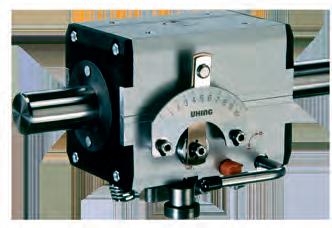
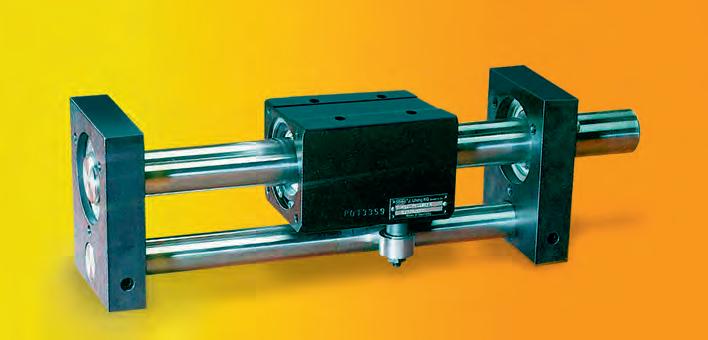
Many different sizes
For more information call

Since the public release of ChatGPT at the beginning of the year, artificial intelligence has become the buzz phrase of 2023. According to Bloomberg, upper management at S&P companies mentioned the term AI more than 1,000 in earning calls in the first quarter alone.
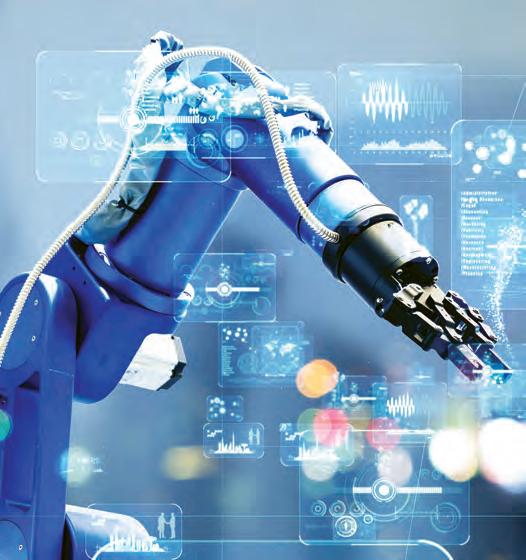
Similarly, robots, cobots and robotic applications have come to dominate industrial trade shows in the last few years as North American manufacturers look to capitalize on the pandemic-induced trend toward re-shoring and/ or friend-shoring while coping with a shortage of manufacturing labor.
The difficulty is that neither, on their own, is easy to implement. According to Gartner studies, 85 percent of AI projects fail to deliver overall and may be even less successful in manufacturing implementations. Similarly, robots can be notoriously difficult to program.
While cobots were designed to lessen the technical kno w-how required, the results may not live up expectations, says the founder and CEO of Toronto-based Xaba.ai, Massimiliano Moruzzi. Too often, he says, cobots end up “in the corner.”
“And the reason is, the capacity to drag this machine with your hands, and really have the machine do the same thing, comes from what is the other expensive part of robotics: You have to grab a lot of data,” he says. “To have a collaborative robot execute
even a little bit of a complex trajectory, you have to move them multiple times, because your hands are not very accurate. I have a feeling the problem is just being moved, kicked a little bit in a different direction. You still have to go through a massive amount of trial and error. And so that’s why the problem has to be formulated different.”
That something different, Moruzzi says, is what Xaba.ai specializes in: The melding of robotics with what he calls an industrial AI.While a large language model like ChatGPT or the diffusion model found in image generation AI can be variable in its output from one instance to the next, industrial AI requires that quality be fundamental, Moruzzi says.
“Industrial AI cannot just
be an AI with the intention of the algorithm to discover a new path,” he says. “That’s good in some field but not in others. What we’re building is an industrial AI because it has to be extremely repeatable, consistent and controllable.”
In a sense, Moruzzi quest for an industrial AI started long before founding Xaba, when he moved to the U.S. from Italy in 2002 to work as the director of engineering for Ingersoll Machine Tools.
While there, he led the team that developed the hardware and software Boeing used to automate the manufacture of the 787 Dreamliner’s carbon fiber wings and fuselage. That same technology also factored into other projects, including a carbon fiber fuel
storage tank for NASA and a carbon fiber stealth drone for the Lockheed Martin’s Skunk Works.
Even before Xaba’s founding last year, those applications formed the foundation for the company’s xTrude platform, an AI-driven control system that models the physics of the FDM additive manufacturing process.
To date, xTrude’s biggest claim to fame has been its use in the production of the three-part chassis of the Auto Parts Manufacturers Association’s Project Arrow zero-emission vehicle.
To create the chassis, Xaba partnered with the Italian firm, Breton, SPA, which specializes in large-scale additive manuf acturing machines for thermoplastic materials. Project Arrow’s chassis was printed with the company’s giant Genesi E3 additive and milling machine that has a print envelope large enough (3 meters high and 5 meters wide, with a variable length) to produce the chassis parts at full scale.
According to Moruzzi, adding Xaba’s xTrude AI component was critical, since it calculates and controls the machine’s printing variables, such as flow rate, extrusion temperature, bead width, etc., so that the printed part achieves the desired performance. That’s no simple task, he says, especially when dealing with an anisotropic material like the carbon fiber reinforced polymer used in Project Arrow’s chassis.
Given the variable







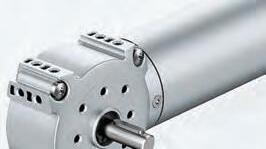

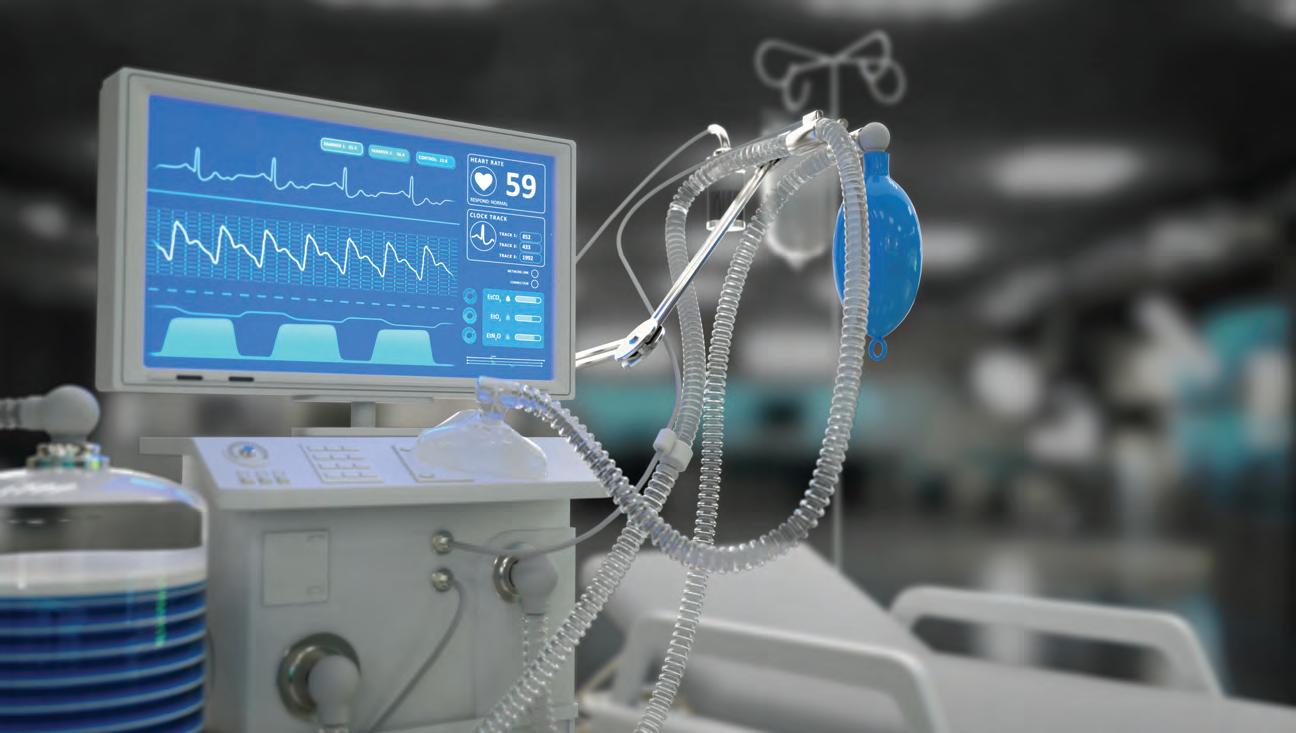





























































Clinics, hospitals, pharmacists and care services require adaptable, highperformance devices that provide you with the best possible support in medical settings. Whether the system has to cool, air condition, lift, pump or drive, ebm-papst’s ventilation and drive solutions make diagnosis and treatment more simple, efficient and cost-effective.
Please contact sales@us.ebmpapst.com for more information.
directional strength properties of carbon fiber, the pr inting process therefore has to factor in where stresses in the part will occur.








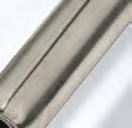







According to Moruzzi, xTrude’s machine learning algorithm models the physics of the 3D printing process to arrive at a solution that takes advantage carbon fiber’s light weight and inherent strength while avoiding its weakness.
Moruzzi says that by enabling this kind of precision 3D printing, Project Ar row’s carbon fiber chassis represents a potentially disruptive change in vehicle manufacturing.
“Currently, any [car] manufacturer is using at least 500 parts, if not 700, in a car chassis,” he says. “So the cost of managing the parts, the CO2 and energy is just a logistical nightmare.[For the













Project Arrow chassis,] there are only three components made with the same material, and the machine is consuming 35 kilowatt per hour to produce the chassis. That’s where the sustainability is interesting.”











In addition to 3D printing applications, Xaba has most recently focused on extending its industrial AI concept to a broader range of robots perfor ming the more traditional manufacturing processes (e.g. drilling, welding, assembling and r iveting) that require a high degree of accuracy and repeatability.


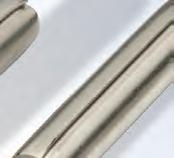

The problem is that programming robots to perform those functions is challenging by itself, Moruzzi says, not to mention finding someone with expertise in kinematics
and one or more of the often proprietary robotic programming languages. Given the difficulty, achieving an acceptable result often drives the cost of robotic applications too high for many.
Mor uzzi says Xaba’s xCognition AI platform addresses these challenges in that it is hardware agnostic, compatible with virtually any brand or type of robot, and in essence writes its own code. The result is a system that significantly improves the accuracy and repeatability of robotic systems beyond what has been achievable with traditional controller software.
“There are three modules inside xCognition,” Moruzzi explains. “One is what we internally call our universal pre-imposed parser that can interface with KUKA, FANUC, ABB,Yaskawa, Denso, whatever the case. There is also a component that allows xCognition to talk with potential sensors that a particular industrial machinery requires to function.”
The second module, he says, comprises xCognition’s machine learning algorithm which captures and models the physics of a robotic system to create what the company calls a “true industrial robotics digital twin.” In essence, this twin is a virtual representation of, not only the physical robot itself, but all the relevant environmental factors that may influence its operation.

Given that virtual model, and a defined goal like welding along a particular path or dr illing in a precise location, xCognition’s machine learning module then runs through multiple iterations of the assigned task until it arrives at a repeatable and precise solution. Along the way, the AI platform
generates and tweaks its own programming using its third module, a large language model AI designed to write robotic code in whatever language is required.
The result, Moruzzi says, is an improvement in accuracy and repeatability that is an order of magnitude beyond that of traditional robotics controllers. As evidence, he points to recent a collaboration with Lockheed Martin, dur ing which the aerospace manufacturer tasked one of its robotic systems a set of drilling tests with specified positional tolerances. According to Lockheed, the dr illing procedure that used Xaba’s xCognition controller was 10 times more accurate than without it.
Currently, Moruzzi says Xaba.ai is focused on building relationships with robotics integrators. In June, the company announced it is collaborating with Italian robotics firm, Rolleri Holding SpA, to develop an autonomous cobot workcell for welding operations that integrates xCognition. From there, he says the goal will be to make robotics as accessible as possible.
“The goal for us, ultimately, is to democratize the use of robots for everybody,” he says. “By doing that democratization process, we aim for Xaba to be an incredible platform of manufacturing knowledge because our system is learning at this point. Every application we do, it grows in learning.”
“When we have that kind of data, try to imagine the impact that we can have,” he adds. “By presenting this data, even at the design level, even in crafting the new machine, even defining a new process, it would be amazing to learn what automation can really do.” |DE www.xaba.ai


Over the last few years, more and more equipment manufacturers have started providing support for the MQTT protocol for sending data from remote devices. As a relatively new standard, you might be wondering what it’s about and how it works. This article provides some background on MQTT, why you might want to use it and how it works.
Invented in 1999 for the oil and gas industry, MQTT was originally designed for use in sending data from equipment in remote locations where there were limited resources – think battery-powered equipment with limited communications bandwidth and limited computing resources

In this sense, it is a lightweight protocol that doesn’t require a lot of overhead and is efficient in using the available bandwidth. It runs on top of a standard data transport mechanism like TCP/ IP that offers bidirectional communication without data loss and
ordered delivery.
The name comes from Message Queue Telemetry Transport but since 2013 it has just been MQTT. IBM released MQTT 3.1 in 2010 as a free and open protocol, and submitted it to the Organization for the Advancement of Structured Information Standards (OASIS) for maintenance in 2013. MQTT is still managed by OASIS, which released the latest revision,Version 5, in 2019.
Central to MQTT is the concept of a message broker. The broker is a server that runs software that acts as an intermediary, receiving messages from clients and then routing or publishing these messages out to other clients. A client can be a publisher, which is a producer of data, and/or a subscriber, which is a consumer of data.
An important part of this architecture is that the publisher has no knowledge of the number or location of any subscribers; it only talks to the
broker. Likewise, the subscribers don’t need to know anything about the publisher. Whether functioning as a publisher, subscriber or both, each client only needs a connection to the broker.
To enable the exchange of specific information, whenever a client publishes data, it includes a topic to identify the data. This topic is the key that clients use when subscribing to messages from certain devices. So, you can see how the role of the broker is key to managing the flow of data from publishers to one or more subscribers.
The MQTT standard defines 14 standard message types to allow clients to connect and disconnect, publish data, acknowledge the receipt of data and manage the connections.
As mentioned before, MQTT relies on the standard TCP/IP protocol to handle moving data. This protocol does not have any inherent built-in security.
However, MQTT can be
configured to use TLS to provide a secure connection using a certificate file, user and password to allow data to be encrypted to prevent modification or unauthorized access. Finally, MQTT includes an optional Quality of Service (QoS) capability to ensure that important messages are properly delivered.
MQTT has many use cases but it’s especially useful in projects where data needs to be collected from a remote location that is updated every few minutes. This can be quite different from a more traditional data logging application where a remote device might be configured to record data every few minutes but store it in internal memory and only upload it once a day.
Being a light-weight protocol, MQTT has an advantage over traditional protocols when sending small amounts of data frequently.
There is much less overhead in establishing the connection and it is much simpler to send a few data values as opposed to sending a whole file every time. For a remote, battery-powered device, using a cellular modem, for example, this translates into having to power the modem for shorter amounts of time to extend battery life.
On the other hand, MQTT is not good for continuously streaming large amounts of real-time data because of the additional work placed on the broker to processing each message. Also, the message format does not lend itself to transferring large blocks of data. Instead, it’s designed to send just a few values for each topic.
When building remote applications, data security is often a concer n. Fortunately, MQTT allows the use of TLS to create a secure connection. A set of key and certificate files, one for the remote device and one for the MQTT
broker, can be generated. With this in place, any data transmitted is encrypted to prevent eavesdropping or tampering.

MQTT is an established data exchange protocol with support showing up on more devices. As an alternative to the common “store data in memory and download” used by data loggers, MQTT allows for more real-time information. It uses a publish/subscribe architecture that relies on broker software to facilitate the exchange between publishers and one or more data subscribers.
The flexibility of this architecture allows it to be used locally within a f acility or remotely between devices in the field and a cloud-based platfor ms. Finally, MQTT supports for encrypted connections using TLS. |DE https://dataloggerinc.com
detect and correct
and
Sustainability is a complex goal that affects every facet of machine design, and no stone is being left unturned in companies’ quest to uncover new opportunities that support that goal. These conditions are driving a multitude of innovations like smart pneumatic sensor s and advanced airflow
technologies.
When applied to compressed air equipment, smart sensor s can reduce energy usage and dramatically lower carbon emissions. With the ubiquity of compressed air applications in manufacturing and industrial environments, this small change represents a big stride along the path toward sustainability.

Pneumatic technology is the workhorse behind innumerable processes and operations in virtually every industry. For pneumatics to function, however, they require compressed air, which is often a facility’s most expensive energy resource. Any opportunity to conser ve this resource is
critical in terms of operating costs and overall sustainability.
Companies with older equipment and processes often don’t have a precise picture of their pneumatic systems or of how efficiently (or inefficiently) their operations are consuming compressed air. A commonly accepted estimate of compressed air waste in any given f acility is 10%. This amount is attributed to both compressed air leaks and processes using more compressed air than is required. The good news is that this loss of 10% also represents an opportunity to recoup that amount in energy savings and lower carbon emissions.
Adding sensors to compressed air equipment t o monitor consumption provides facilities with the insights that allow them to precisely control their usage.
The AVENTICS Series AF2 Flow Sensor allows operators to monitor pneumatic system air consumption, leaks prevent leaks before they occur.Digitizing pneumatic operations also enables companies to capture and view real-time conditions, equipping them with the information they need to practice predictive maintenance and resolve leaks early or before they happen.
Compressed air monitoring can also enable operators to fine-tune the amount of compressed air a particular machine uses while maintaining cycle times. By monitoring and intentionally controlling usage, facilities can save energy and reach their decarbonization targets by lowering emissions.
The digitalization of pneumatic systems makes it possible for virtually any operation to make better, more informed decisions. With the advanced monitoring now available, operators can accurately see how much energy their compressed air processes are using and why. This allows them to perform calculated actions that move them closer to their sustainability goals.
In pneumatic systems, digitalization is the application of intelligent airflow sensor s to capture data and turn it into actionable information. Many of these types of sensors are simple to install and can be retrofitted to existing equipment. They are also scalable and can be applied to one machine or to multiple machines across an operation. The flexible application of smart sensors makes them an effective tool that can easily fit within a larger digitalization plan.
Some of the most advanced airflow sensors can measure man y different process parameters, including: Pressure, temperature,
volumetric flow rate, mass flow rate, flow velocity, total volume, total mass and energy at the machine level. These sensors may also feature a configurable display from which operators can view data and configure their own visual representations and flow charts for data such as measurements, process curves and cumulative values.
For some sensors, the systematic data-capture and capabilities are so advanced that operators can monitor air consumption in accordance with DIN ISO 50001 for energy management—an ISO standard that helps establish, implement, maintain and improve energy management systems.
In addition, smart sensors like these can be combined with a gateway and software that allows operators to view dashboards, record and store historical data and set parameters that trigger alert notifications. They can also perform complete leakage analysis, correlate data with other sensors and produce a complete site accounting.
To support sustainability, Emerson has installed its AF2 airflow sensors, installing 19 of them in half of the machines in its plant in Sissach, Switzerland.
At the Sissach plant, the compressed air dashboard displays data from all 19 connected sensors, providing operators with a big-picture view of pneumatic systems. Additionally, advanced analytics like temperature, pressure and volume trends deliver an aggregated, plantwide overview while also allowing an operator to drill down into a single machine’s metrics.
In the Sissach application,

the impact has been remarkable. The plant identified a loss of 850 liters per minute of compressed airflow, or about 20% of total airflow, that was attributed to leaks.
To put this in energy terms, that represents $58,000 in energy savings and a 68,000kg carbon reduction over a 10-year period. Overall, the return on investment was estimated at 18 to 24 months; however, within five months the savings reached 50% of the payback amount.
What’s more, this compressed air monitoring solution allowed operators to find energy optimization opportunities. Savings were quickly gained with data and visualizations. Over the long term, the insights provided will continue to have a positive impact. This solution
can also scale across multiple sites. Emerson plans to expand compressed air monitoring to 80% of its Sissach machines. The company has also begun monitoring other plants in Singapore, Malaysia and India.
To achieve decarbonization and sustainability g oals, companies need the support of the designers, engineers and OEMs who understand the role of digitalization within their facilities. Smart solutions like adv anced airflow sensors for pneumatic systems are just one example. |DE www.emerson.com
Jan Edler is IIoT Manufacturing Applications Leader at Emerson. Dr. Michael Britzger is Director, IIoT Engineering for Discrete Automation at Emerson.
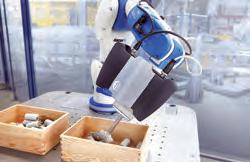
Electromate Inc. announced it will distribute cobot screwdriving solutions, by Danish accessories manufacturer, Spin Robotics. Designed to integrate with Universal Robots’ cobots, Spin’s SD70 and SD35 packages include end-of-arm tooling for screwdriving. The SD70 package includes a screwdriving tool and control box, as well as the programming and configuration software for the cobot. Designed for the UR3, UR5, and UR10 cobots, the SD70 is suitable for assembly, packaging and material handling applications. The SD35 package includes the same general hardware and compatibility but is intended for more compact and lightweight applications, including electronics assembly and medical device manufacturing.

www.electromate.com
Mobile Industrial Robots (MiR) announced the release of the MiR Hook 250, an Autonomous Mobile Robot (AMR) top module, designed to fully automate the pick-up and towing of carts in production, logistics and healthcare environments. Paired with the MiR 250 AMR, the module supports the transport
of loads up to 500kg (1100 lbs) and a top speed of 2.0 m/s (7.2 km/h). The MiR250 robot identifies carts by April Tags and autonomously transports them as defined. After feeding the towed cart’s measurements into the AMR software, the robot’s built-in 3D cameras and proximity sensors allow the MiR 250 to maneuver around people and obstacles.
www.advancedmotion.com
Comau introduced its MI.RA/ PICKER, an automated, perception-based random bin picking system. Adaptable to any brand of commercial robot, customized bin or customized gripper, the system uses two high-resolution laser sensors and a central 3D vision camera to autonomously recognize, locate and grasp randomly placed objects at a rate of up to 40 pieces per minute (PPM). The system also includes virtual simulation tools and predictive algorithms for optimal path management and collision-free trajectories, the company says. Because products don’t need to be placed into bins in an orderly manner, the company says its MI.RA/Picker reduces upstream process times while ensuring a simplified logistic flow without singularization of the parts or rigid fixtures.

www.comau.com

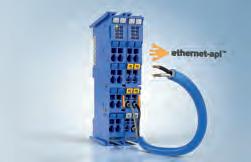
Beckhoff unveiled its ELX6233 EtherCAT Terminal that simplifies integration with Ethernet-APL as well as field devices in the hazardous areas of zones 0/20
and 1/21. Ethernet-APL – short for Advanced Physical Layer – allows for cable lengths up 1,000 meters (200 meters in intrinsically safe environments) and speeds of 10 Mbit/s. The ELX6233 connects to sensors according to the SPAA (TS10186) port profile and integrates them into the system via PROFINET. Two APL ports are available for this purpose in the space-saving 24-mm terminal housing. This allows the data from the connected sensors to be transmitted to the controller and to the higher-level process control system (DCS) via ultra-fast EtherCAT communication.
www.beckhoff.com

igus has launched its readychain p-rack (printed rack), a pre-assembled cable carrier solutions with a 3D-printed e-chain that can be customized to the millimeter. According to igus, the readychain p-rack can be manufactured faster and lighter than its metal predecessor. The company says it is up to 80% lighter and can be assembled and disassembled without additional hand tools. In addition, custom carriers can be printed in just 36 hours. All p-rack attachments can also be printed from corn starch, which igus says is rustproof but is also compostable or entirely regranulated and reused. https://www.igus.com

Moxa Inc. unveiled its AWK3252A wireless AP/bridge/client targeted for mobile automation (AGV/AMR) systems and IP surveillance systems. Capable of concurrent dual-band Wi-Fi, the access point offers 802.11ac with DFS channel support, WPA3 encryption, aggregated data rates up to 1.267 Gbps, and client-based Turbo Roaming for <150 ms recovery time between APs. It also includes two DC power inputs plus it can be powered via PoE. The AWK-3252A is compliant with IEC 62443-4-2 and IEC 62443-4-1 Industrial Cybersecurity certifications. It is also protected within a metal IP30-rated housing with DIN-Rail mounting or optional wall mounting. Integrated antenna isolation safeguards against external electrical interference. The unit is certified for Class 1, Division 2 (C1D2) areas.
www.moxa.com
Rockwell Automation has launched its ArmorKinetix distributed servo drives, an extension of the company’s Kinetix 5700 platform. The line features an architecture that
mounts the drive outside an electrical cabinet. It also includes vibration and thermal sensors that can detect potential machine issues. Available as a distributed servo drive or as an integrated servo/motor, it offers power output up to 5.5KW. With IP66 certification, the line also features CIP Security capability and integrated safety technology capable of achieving the SIL 3 standard.
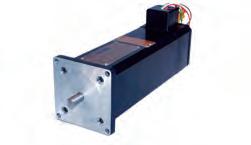
www.rockwellautomation.com






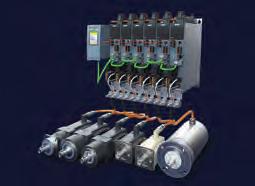
Siemens has introduced its SINAMICS S210, a servo-drive
system comprising a digitally native drive with a range of motors and gearboxes. The system offers DC link coupling on 3-phase units. Corresponding SIMOTICS synchronous motors feature high-resolution 22- or 26-bit absolute encoders, single or multi-turn. One-cable connectivity is standard and all motors feature IP64, IP65, IP67 or IP69X protection. The SINAMICS S210 features an embedded web-server or Startdrive integrated with the Siemens TIA Portal. The S210 is capable of communicating status through Edge or cloudbased data capturing. For cybersecurity, SINAMICS S210 features Security Chip Integration and UMAC program protection within TIA Portal. With Safety Integrated onboard, the servo-drive system offers up to SIL3 level of protection.
www.siemens.com
24-7-365
Kollmorgen announced that its 480 Vac Goldline EBH model has attained ATEX certified status and is IECEx/cETLus listed. For high-voltage applications in hazardous locations, Goldline EBH servo motors offer speeds up to 7,500 rpm with high torque density, the company says. The line also features resolver feedback and a built-in thermostat support. The Goldline EBH servo motor series is available in frame sizes 1 to 6. For its explosion-proof models, Kollmorgen applies a flameproof method of protection so that any internal ignition is contained within the motor housing without
the possibility of escape into the external atmosphere. The maximum surface temperature of the motor under fault conditions is 200°C.
www.kollmorgen.com
Rollon introduced its TLS Series of telescoping linear actuators, designed for applications with minimal vertical clearance. Available in two- or three-stage versions, the actuators feature a telescopic design that enables long stroke lengths with minimal closed lengths. It also features a
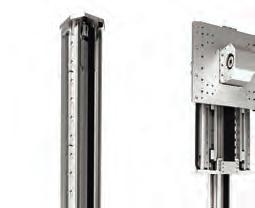
synchronized drive system, requiring a single motor, and are equipped with a built-in automated lubrication system. The series comes in four sizes (100, 230, 280 and 360) with up to a 3,000-millimeter stroke length in a single direction. Maximum speed tops out at 6 meters/second with acceleration up to 20 meters/second. Repeatability is down to ±0.05 millimeters.
www.rollon.com
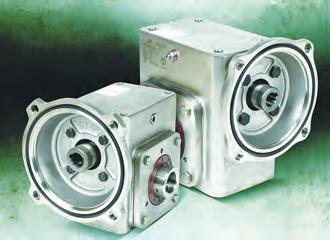
AutomationDirect now offers IronHorse stainless steel worm gearboxes. The stainless steel housings of these gearboxes make them suitable for the food and beverage industry and many other harsh industrial applications, the company says.
The gearboxes are IP69K
rated and BISSC certified (Baking Industry Sanitation Standards Committee) with the housing, covers and flanges all made out of 304 stainless steel. They are available in gear ratios from 5:1 to 60:1 and the input flanges accept 56C or 145TC motor frames. All IronHorse stainless steel worm gearboxes have a hollow shaft output. Single and dual output shaft kits are available as are shaft bushings. Compatible output covers and output flanges are also available.
www.automationdirect.com

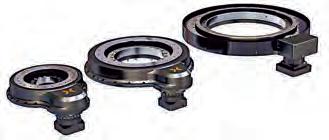
Nexen Group, Inc., announced its X-Line of rotary indexers deliver up to three times more torque and greater moment load capacity, the company says. The X-Line also features a redesigned roller pinion and a larger gear pitch to handle higher torque capacities that deliver accuracy, fast acceleration, high-speed positioning, increased load capacity, and true repeatability. The line’s mounting features and the additional fastening points of the rigid cast housing are designed for a greater moment load capacity than a standard design. Additionally, systems can be designed for low or zero backlash to meet the project specifications.
www.nexengroup.com

Harmonic Drive LLC released its CSF-2XH mini gearhead, designed for servo and stepper motors. Available with an output shaft or flange, the line is offered in four sizes with gear ratios 30:1 to 100:1 and peak torque of .5~28Nm. Designed for semiconductor and robotics applications, the mini strain wave gears feature zero
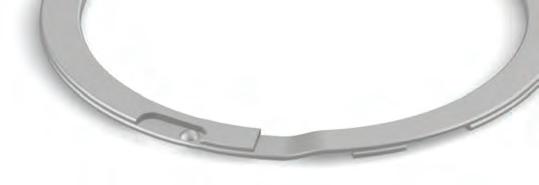
backlash and accuracy of ± 1.5 to 10 arc-min. The line comes in diameters from 22mm-53mm with S tooth profile and a 4-point ball bearing mounted in main shaft. Both flange (F) or shaft (J) output are available.
www.harmonicdrive.net



JW Winco has introduced two angular gear boxes that translate rotational movements by 90 degrees. The GN 3971 bevel gear box is available in seven sizes with
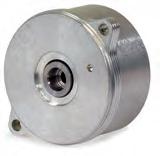
housing lengths between 1.26 and 2.36 inches (32 and 60mm) and widths between 0.71 and 1.38 inches (18 and 35mm). The gear shafts can receive axial and radial forces of 13.9 lbf (60 newtons) on the smallest model and 124 lbf (550 newtons) on the largest. The GN 3975 worm gear reducer measures 2.36 inches (6mm) on the sides and 1.38 inches (35mm) in width. Seven versions provide gear ratios between 1:13 and 1:65. The maximum radial and axial force ranges between 44.96 and 112 lbf (200 and 500 newtons) on
the input side and is always 112 lbf (500 newtons) on the output side. Starting with a gear ratio of 1:18, a static self-locking mechanism prevents the rotation of the worm gear from the output side.
www.jwwinco.ca

HEIDENHAIN launched its EnDat 3, an updated version of its absolute position encoder interface. The latest model uses a 200 kHz clock frequency (16 kHz in previous versions) and has double the bandwidth, from 12.5 to 25 Mb/s. In addition, EnDat 3 supports
black channel and has reduced cabling requirements, requiring a two or four-wire setup. The EnDat 3 also offers bus operation and has increased memory and storage capacity. The new interface also supports an increased number of temperature sensors and features added support for multi-dimensional encoders. Like all the versions of EnDat, the EnDat 3 is bi-directional, so it can support monitoring and diagnostics.
www.heidenhain.us
Electromate announced it now distributes Quantum Devices’ QM22 series of optical incremental encoders. Suited to a

range of applications, including robotic arms, automated guided vehicles (AGVs) and medical equipment, the QM22 is designed for integration into tight spaces. Measuring 22mm in diameter, encoder series offers resolutions up to 2,048 cycles per revolution (CPR) or 8,192 counts per revolution when used with a x4 count quadrature decoder. The series also features a fully encapsulated housing that ensures optimal operation even in challenging industrial environments, the company says.
www.electromate.com


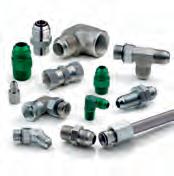

HBK has released the U9C and C9C with IO-Link, digital force sensors that have the same mechanical dimensions and threads as their analogue counterparts. Offering the benefits of digital signal processing, the miniature force sensors detect and identify instances where technical limits, such as maximum usage forces or peak-to-peak values, are exceeded, and subsequently issue appropriate warnings. More resistant to EMC (electromagnetic compatibility) interferences than their analogue predecessors, U9C and C9C with IO-Link consistently deliver only the data requested, increasing data efficiency and reducing the volume of data to be processed.

www.hbkworld.com
EXAIR announced that its Model 9207 Ultrasonic Leak Detector (ULD), a hand-held instrument designed to locate compressed air system leaks, has received a look and function upgrade. Testing can be performed at distances up to 20 feet (6.1m). High pressure gases create high frequency turbulence when moving into an area with lower pressure, creating an ultrasonic or “white noise” sound that is beyond the range of human hearing. The ULD can detect these vibrations and can be adjusted to filter out background noise in busier plants. This latest model offers a heightened ability to detect leaks in hard-to-reach areas while also complying with the IEC 61326-1 standard that designates its ability to operate in typical electromagnetic environments.
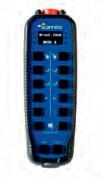
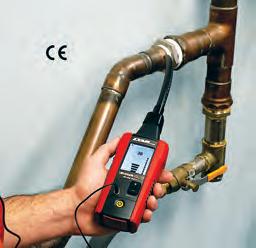
https://exair.co

Emergent Vision Technologies introduced its Pinnacle TLZ-9KG5, a 100GigE line scan camera, featuring a QSFP28 interface with a top single line rate of 608 kHz. The camera also features the 9K, 256-stage time delay integration (TDI) Gpixel GLT5009BSI CMOS sensor with a 5x5 µm pixel size and a 45.36mm sensor scanning width. Both GigE Vision and GenICam compliant, the camera supports cable lengths from 1M up to 10KM without fiber converters/ repeaters. The camera also features internal rotary or linear encoder support, as well as an M52 mount, 1 µs–1 s exposure/ integration time, 66 dB dynamic range, flat shading and spatial corrections and Windows and Linux compatibility.
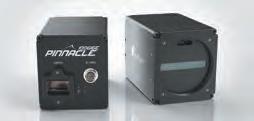
www.emergentvisiontec.com



